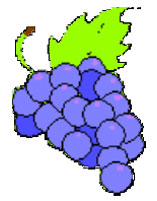CHAPTER 9
CANCER
The Mystery of Life
Before we start with cancer – that is abnormal cell reproduction – let’s take a brief look at some of the mysteries of life. In essence, our organism is a super complicated array of chemical substances, which work together in a meaningful and productive way that we call “life”. Such thing can not appear by chance and was created by our loving God and father. His wisdom is infinite. Observe for example the close similarities between cholesterol and vitamin D3 or between testosterone and estrogen, the male and female hormones. Minimal changes in the connections between some atoms result in great differences in their functions. Men and women are so similar and so different…

It is therefore easy to comprehend how complicated must be the mechanisms to maintain the order in this complex system and how easy it could be disturbed. Think about how heat can change healthy cis-fats into harmful trans-fats. We live only through God’s permanent power and grace. We have seen how the psycho-neuro-immune system and the endocrine system work together in all regulatory functions. It is easy to realize how important nutrition is to provide the correct amount and proportions of chemicals to maintain a healthy state.
Well, this was the perfect condition when man was created. “God saw all that he had made, and it was very good.” (Genesis 1:31) Sin brought changes that caused a progressive decay. Ellen G. White makes a good description of the degeneration of man after the fall:

“In infinite wisdom, the world which God had newly formed was placed under fixed laws. Laws were ordained, not only for the government of living beings, but for the operations of nature. Man was created subject to law. He was to glorify God by a life of obedience to the divine laws, including those that relate to his physical organization.” (Ellen G. White, Pacific Health Journal, February 1, 1902)
Degeneration of the Human Race
“Since the fall, the tendency of the race has been continually downward, the effects of sin becoming more marked with every successive generation. But so great was the vitality with which man was endowed that the patriarchs from Adam to Noah, with a few exceptions, lived nearly a thousand years. Moses, the first historian, gives an account of social and individual life in the early days of the world’s history; but we find no record that an infant was born blind, deaf, crippled, or imbecile. Not an instance is recorded of a death in infancy, childhood, or early manhood. Obituary notices in the book of Genesis run thus: ‘And all the days that Adam lived were nine hundred and thirty years; and he died.’ ‘And all the days of Seth were nine hundred and twelve years; and he died.’ Concerning another, the record states, ‘He died in a good old age, an old man, and full of years.’ It was so rare for a son to die before his father that such an occurrence was thought worthy of record: ‘Haran died before his father Terah.’
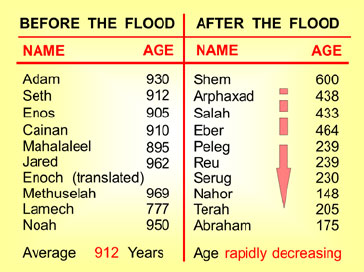
“At the time of Christ’s first advent, humanity had so degenerated that many endured a terrible weight of misery; and not only the old but the middle-aged and the young were brought to the Saviour from all the country around, to be healed of their diseases.
“Still more deplorable is the condition of the human family at the present time. Diseases of every type have been developed. Thousands of poor mortals with deformed, sickly bodies and shattered nerves, are dragging out a miserable existence. The infirmities of the body affect the mind, and lead to gloom, doubt, and despair. Even infants in the cradle suffer from diseases resulting from the sins of their parents.
“There is a close relation between the moral law and the laws that God has established in the physical world. If men would be obedient to the law of God, carrying out in their lives the principles of its ten precepts, the principles of righteousness that it teaches would be a safeguard against wrong habits. But as, through the indulgence of perverted appetite, they have declined in virtue, they have become weakened through their own immoral practices and their violation of physical laws. The suffering and anguish that we see everywhere, the deformity, decrepitude, disease, and imbecility now flooding the world, make it a lazar-house in comparison to what it might be even now if God’s moral law and the law which He has implanted in our being were obeyed. By his own persistent violation of these laws, man has greatly aggravated the evils resulting from the transgression in Eden.
“Against every transgression of the laws of life nature utters her protest. She bears abuse as long as she can; but finally retribution comes, and the mental as well as the physical powers suffer. Nor does the punishment fall on the transgressor alone; the effects of his indulgence are seen in his offspring, and thus the evil is passed on from generation to generation.
“Because mankind have, by the transgression of these laws, departed so far from God’s purpose in their creation, and have brought upon themselves such untold woe, a reform in habits relating to health has become an important branch of the great work of God in the earth. The soul temple has been polluted, and men are called upon to awake, and win back their God-given manhood.” (Ellen G. White, Pacific Health Journal, February 1, 1902)
With this background in mind it is easy to understand how delicate functions like cell reproduction can go wrong resulting in the growth of abnormal tissues called “cancer”.
Normal Cell Reproduction
Our bodies are composed of more than a billion cells. Cells are continually dying and new cells are continually being formed. An identical copy of our hereditary material is found in the nucleus of each and every somatic cell. By viewing a nucleus under a microscope our chromosomes can actually be seen.

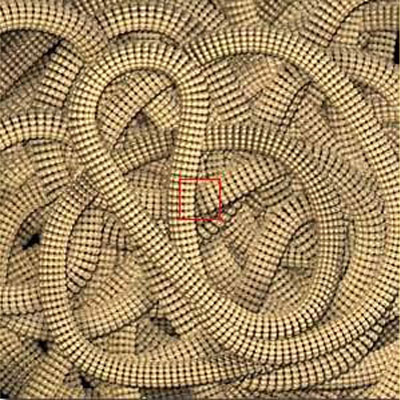 A section of DNA that tells the cell to display a certain characteristic, or produce a certain particular chemical is called a gene. Each cell in your body contains 40,000 different genes.
A section of DNA that tells the cell to display a certain characteristic, or produce a certain particular chemical is called a gene. Each cell in your body contains 40,000 different genes.
In a pair, each “arm” of the chromosome contains identical information along its length; e.g. both arms contain the gene for eye color, hair color etc. The genes are arranged in the same order in both arms. Each time a cell divides, each chromosome must be carefully replicated (copied).
There are 4 different types of nitrogenous bases that can be found in the nucleotides of a DNA molecule. Each base is usually known by the first letter of its name;

DNA Double Helix
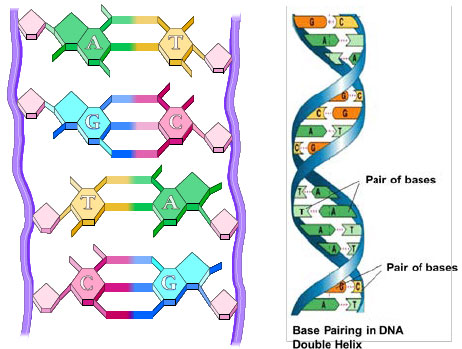
Chromosome Replication

Due to the obligatory pairing of A-T and G-C, each parent strand becomes a template for copying a whole new DNA helix. Since the DNA structure can be rebuilt on both parent strands, two identical DNA helices are produced, each containing one original parent strand and one newly synthesized strand, called a complementary strand.
 Normal Cell Development
Normal Cell Development
The following figure shows normal blood cell formation from embrionary hematopoietic stem cells. Notice that as an embrionary, immature, undifferentiated cell matures, it becomes differentiated, that means specialized. Mature cells have highly specialized functions but lose the ability to reproduce themselves. New cells can originate only from the embrionary stem cells.
Notice also that an undifferentiated stem cell has the ability to develop into different lines. But once a cell matures in a line it cannot change into another line.
 What is Cancer?
What is Cancer?
A cell needs to divide in order to preserve the organism that it supports. In normal cells, the rate of new cell growth is kept in balance with the rate at which old cells die. In cancer cells this balance is disrupted either by the loss of normal growth control or the loss of a cell’s ability to undergo programmed cell death, known as apoptosis.
Cancer cells originate when a cell does not replicate itself perfectly, this increases its chance of genetic mutation. These cancer cells and their offspring then multiply uncontrollably and can invade and damage nearby tissue. Cancer cells are completely “egoistic” in their behavior. They don’t obey the laws and don’t respect their neighbor cells. They only want to eat and grow without being useful. They don’t produce any normal secretion nor do they produce muscular work.
 Protection of the Chromosome Ends
Protection of the Chromosome Ends
To prevent the loss or mutation of essential genes, the end of each chromosome is tied up by a special strand of DNA called a telomere.
Telomeres cap our chromosomes preventing them from a wide range of otherwise catastrophic events and enable the DNA molecule to replicate. Telomeres therefore play an important role in maintaining the integrity of the DNA in our cells. In normal cells with each successive round of cell division, telomeres progres-sively decrease in length. The more times a cell divides, the shorter the telomere becomes and ultimately after a limited number of cell divisions, the length of the telomere becomes so short that the cell ceases to divide.
The telomeres of certain cells do not shorten with progressive divisions; these cells are stem cells, germline cells and cancer cells.
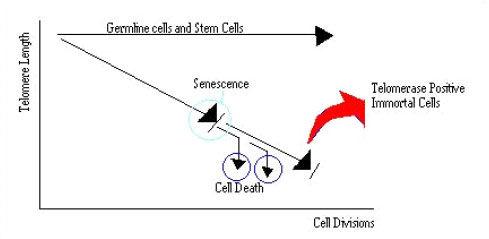 Almost all tumor cells have markedly shortened telomeres in comparison to their counterparts in normal cells. This indicates that the initial formative stages of cancer development must involve the erosion of telomeres.
Almost all tumor cells have markedly shortened telomeres in comparison to their counterparts in normal cells. This indicates that the initial formative stages of cancer development must involve the erosion of telomeres.
Another important characteristic to note is that telomeres in tumor cells are maintained at a constant length.
What is Cancer?
- A cancer is an uncontrolled proliferation of cells.
- Cancers are clones. No matter how many trillions of cells are present in the cancer, they are all descended from a single ancestral cell.
- Cancer cells are usually less differentiated than the normal cells of the tissue where they arose.
- Evidence is accumulating that cancers arise in precursor cells – stem cells – of the tissue: cells that are dividing by mitosis producing daughter cells that are not yet fully differentiated.
- Cancer cells contain several (6-8) mutated genes.
When a few genes in one cell become damaged, this can lead to cancer. These faulty genes may tell the cell to multiply at the wrong time, or in the wrong place. This is how cancer starts. Sometimes the cell-cycle checkpoints themselves are faulty or the damaged cells are able or side-step them.
How Cancer Spreads
 Metastasis is the spread of cancer from one part of the body to another. Tumors formed from cells that have spread are called secondary tumors and contain cells that are similar to those in the original (primary) tumor.
Metastasis is the spread of cancer from one part of the body to another. Tumors formed from cells that have spread are called secondary tumors and contain cells that are similar to those in the original (primary) tumor.
Tumors are called malignant because they have the ability to invade normal tissues (replacing healthy cells with cancer cells) and to metastasize (spread) to other parts of the body. When a certain type of cancer spreads to another part of the body, it does not change its type.
Metastases takes place in many ways: through the lymphatic system, through the bloodstream, by spreading through body spaces such as the bronchi or abdominal cavity, or through implantation. The most common way for cancer to spread is through the lymphatic system. This process is called embolization.
Cancers can also spread by local invasion – that is, by intruding on the healthy tissue that surrounds the tumor. An example of this kind of cancer is basal cell carcinoma of the skin. When this kind of cancer is removed by surgeon, a wide area of healthy tissue surrounding it is also removed and it is usually “cured” immediately. Unless some cells have been left behind, it is very unlikely that it will recur. (However, it is possible that a second cancer of the same kind may start to grow at a later time at a completely different site – the new growth having nothing to do with the first.)
Alcohol and Cancer
“Alcohol drinking has long been known to cause cancers of the oral cavity, pharynx, larynx, oesophagus, and liver. The addition of breast cancer and colorectal cancer, two of the most common cancers worldwide, to this list indicates that the burden of cancer attributable to alcohol consumption is higher than previously thought. The scientific evidence relating alcohol drinking to an increased risk of cancer continues to grow as does the contribution of alcohol drinking to the global cancer burden. The clear association with increased risk of breast cancer associated with even modest levels of alcohol drinking is a major concern particularly in view of the changing drinking patterns of women in many countries.” (International Agency for Research on Cancer [IARC] of the WHO, 28 March 2007. www.iarc.fr/ENG/Press_Releases/pr175a.html) See also www.genomics.unc.edu/articles/rusyn_who_assessment.htm
Cancer and Meat Eating
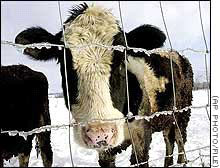
 “Cancer, tumors, and all inflammatory diseases are largely caused by meat-eating. From the light which God has given me, the prevalence of cancers, and tumors is due to gross living on dead flesh. I sincerely and prayerfully hope that as a physician you will not forever be blind upon this subject. . . Feeding on flesh the juices and fluids of what we eat passes into the circulation of our blood, and as we are composed of what we eat, we become animalized. Thus a feverish condition is created because the animals are diseased and by partaking of their flesh we plant the seeds of disease in our own tissue and blood.” (Letter of E.G. White to Dr. Maxson, 5 November 1896. Spalding and Magan Collection, p. 47)
“Cancer, tumors, and all inflammatory diseases are largely caused by meat-eating. From the light which God has given me, the prevalence of cancers, and tumors is due to gross living on dead flesh. I sincerely and prayerfully hope that as a physician you will not forever be blind upon this subject. . . Feeding on flesh the juices and fluids of what we eat passes into the circulation of our blood, and as we are composed of what we eat, we become animalized. Thus a feverish condition is created because the animals are diseased and by partaking of their flesh we plant the seeds of disease in our own tissue and blood.” (Letter of E.G. White to Dr. Maxson, 5 November 1896. Spalding and Magan Collection, p. 47)
 “The effects of a flesh diet may not be immediately realized; but this is no evidence that it is not harmful. Few can be made to believe that it is the meat they have eaten which has poisoned their blood and caused their suffering. Many die of diseases wholly due to meat eating, while the real cause is not suspected by themselves or by others.” (Ministry of Healing, 315)
“The effects of a flesh diet may not be immediately realized; but this is no evidence that it is not harmful. Few can be made to believe that it is the meat they have eaten which has poisoned their blood and caused their suffering. Many die of diseases wholly due to meat eating, while the real cause is not suspected by themselves or by others.” (Ministry of Healing, 315)
“The common use of the flesh of dead animals has had a deteriorating influence upon the morals as well as the physical constitution. Ill health in a variety of forms, if effect could be traced to the cause, would reveal the sure result of flesh eating.” (Medical Ministry, 222)
Protein and Cancer

He could trigger cancer growth on by giving more than 10% protein in the meal. It could be brought to stop by low levels of only 5%. Plant protein did not promote cancer growth even at high levels of intake. (The China Study, 2003, p. 43-67)

“Vegetables and fruits are a rich source of a number of nutrients…. There is consistency in the evidence that vegetables and fruits play some protective role in preventing the development of cancers.”
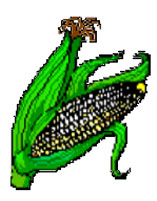
The director of the National Cancer Institute’s division of Cancer Prevention and Control of the USA concluded: “A greater number of studies have shown that a diet rich in fruits and vegetables has a protective effect against cancer. Persons with high fruit and vegetable intakes have about half the risk of people with low intakes.” (Better Nutrition, May 1994, p. 20)
Phytochemicals are found especially in the dark colors of the plants like blueberries, cranberries, tomatoes, red bell peppers, etc.
A Call for Reformation
 “Greater reforms should be seen among the people who claim to be looking for the soon appearing of Christ. Health reform is to do among our people a work which it has not yet done. There are those who ought to be awake to the danger of meat eating, who are still eating the flesh of animals, thus endangering the physical, mental, and spiritual health. Many who are now only half converted on the question of meat eating will go from God’s people to walk no more with them.” (Counsels on Diet and Foods, p. 382)
“Greater reforms should be seen among the people who claim to be looking for the soon appearing of Christ. Health reform is to do among our people a work which it has not yet done. There are those who ought to be awake to the danger of meat eating, who are still eating the flesh of animals, thus endangering the physical, mental, and spiritual health. Many who are now only half converted on the question of meat eating will go from God’s people to walk no more with them.” (Counsels on Diet and Foods, p. 382)
-o-O-o-

 Normal Cell Development
Normal Cell Development  Protection of the Chromosome Ends
Protection of the Chromosome Ends 